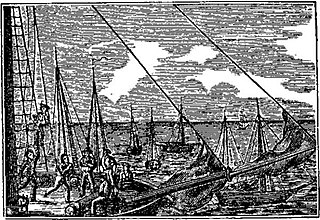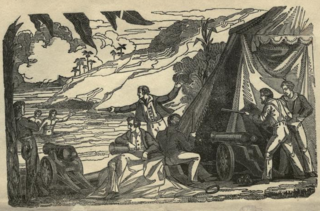Related Research Articles

Buccaneers were a kind of privateer or free sailors particular to the Caribbean Sea during the 17th and 18th centuries. First established on northern Hispaniola as early as 1625, their heyday was from the Restoration in 1660 until about 1688, during a time when governments in the Caribbean area were not strong enough to suppress them.

Bartholomew Roberts, born John Roberts, was a Welsh pirate who was, measured by vessels captured, the most successful pirate of the Golden Age of Piracy. During his piratical career, he took over 470 prize ships. Roberts raided ships off the Americas and the West African coast between 1719 and 1722; he is also noted for creating his own pirate code, and adopting an early variant of the Skull and Crossbones flag.
William Wright was an English privateer in French service and later buccaneer who raided Spanish towns in the late 17th century.
This timeline of the history of piracy in the 1680s is a chronological list of key events involving pirates between 1680 and 1689.

Robert Searle was one of the earliest and most active of the English buccaneers on Jamaica.

Thomas Anstis was an early 18th-century pirate, who served under Captain Howell Davis and Captain Bartholomew Roberts, before setting up on his own account, raiding shipping on the eastern coast of the American colonies and in the Caribbean during what is often referred to as the "Golden Age of Piracy".

Bartholomew Sharp was an English buccaneer and privateer. His career of piracy lasted seven years (1675–1682). In the Caribbean he took several ships, and raided the Gulf of Honduras and Portobelo. He took command of an expedition into the Pacific and spent months raiding settlements on the Pacific Coast of South America including La Serena which he torched in 1680. His flagship, taken at Panama, was the Trinity.

Edward Davis or Davies was an English buccaneer active in the Caribbean during the 1680s and would lead successful raids against Leon and Panama in 1685, the latter considered one of the last major buccaneer raids against a Spanish stronghold. Much of his career was later recorded by writer William Dampier in A New Voyage Round the World (1697).
Captain John Coxon, sometimes referred to as John Coxen, was a late-seventeenth-century buccaneer who terrorized the Spanish Main. Coxon was one of the most famous of the Brethren of the Coast, a loose consortium of pirates and privateers. Coxon lived during the Buccaneering Age of Piracy.
Jan Willems, also known as Janke or Yankey Willems, was a 17th-century Dutch buccaneer. Based out of Petit-Goâve, Willems participated in a number of expeditions against the Spanish during the early to mid-1680s with other well-known privateers including Michiel Andrieszoon, Thomas Paine, Laurens de Graaf, Nicholas van Hoorn and Michel de Grammont.

Joseph Bannister was an English pirate who operated in the Caribbean during the Golden Age of Piracy. He is best known for defeating two Royal Navy warships in battle.

The Flying Gang was an 18th-century group of pirates who established themselves in Nassau, New Providence in the Bahamas after the destruction of Port Royal in Jamaica. The gang consisted of the most notorious and cunning pirates of the time, and they terrorized and pillaged the Caribbean until the Royal Navy and infighting brought them to justice. They achieved great fame and wealth by raiding salvagers attempting to recover gold from the sunken Spanish treasure fleet. They established their own codes and governed themselves independent from any of the colonial powers of the time. Nassau was deemed the Republic of Pirates as it attracted many former privateers looking for work to its shores. The Governor of Bermuda stated that there were over 1,000 pirates in Nassau at that time and that they outnumbered the mere hundred inhabitants in the town.
Thomas White was an English pirate active in the Caribbean and the Indian Ocean. He was only briefly a captain on his own, but served under several more prominent captains such as George Booth, John Bowen, Thomas Howard, John Halsey, and Nathaniel North.
Lieutenant Richards was a pirate active in the Caribbean and off the Carolinas. He is best known for sailing alongside Blackbeard.
Jelles de Lecat was a Dutch pirate and buccaneer who sailed for and against both the English and Spanish. He served with Henry Morgan and was often called "Yellahs," "Yallahs," or “Captain Yellows.”
Jacob Evertson was a Dutch buccaneer and pirate active in the Caribbean. He escaped Henry Morgan and sailed with Jan Willems for several years.

William Lewis was a pirate supposedly active in the Caribbean, off the American east coast, and off the west coast of Africa in the 18th century. He was known for sparing his victims and for being killed after announcing he had made a pact with the Devil. He is likely the fictional creation of "Captain Charles Johnson" who presented his story among those of real historical pirates.

Henry Johnson was an Irish pirate active in the Caribbean. He shared captaincy with a Spaniard, Pedro Poleas. Johnson was best known thanks to an autobiography written by a sailor he captured and marooned.
Jacob Fackman was an English buccaneer and pirate active in the Caribbean. He is best known for attacking the Spanish alongside Henry Morgan, John Morris, and David Marteen.
John Read was an English buccaneer, privateer, and pirate active from South America to the East Indies to the Indian Ocean.
References
- ↑ Selinger, Gail; Smith, W. Thomas (2006). The Complete Idiot's Guide to Pirates. Penguin. ISBN 978-1-59257-376-9.
- ↑ Walford, L. A. (1940). Wonder Creatures of the Sea. Copeia 1940 (3): 209.
- ↑ Pitcaithly, Marcus (15 July 2014). "Pirate Corner: The kilted buccaneer". Marcus Pitcaithly. Retrieved 11 April 2018.
- 1 2 3 Selinger, Gail; Smith, W. Thomas Jr. (2006). The Complete Idiot's Guide to Pirates. New York: Penguin. p. 109. ISBN 9781592573769 . Retrieved 11 April 2018.
- 1 2 Humanity, History of. "Buccaneers | "Red Legs" Greaves". www.goldenageofpiracy.org. Retrieved 11 April 2018.
- 1 2 3 Karg, Barb; Spaite, Arjean (2007). The Everything Pirates Book: A Swashbuckling History of Adventure on the High Seas. Avon MA: Simon and Schuster. ISBN 9781605502694 . Retrieved 11 April 2018.
- 1 2 Ossian, Rob. ""Red Legs" Greaves". www.thepirateking.com. Retrieved 11 April 2018.
- ↑ Peter, Dorris, M. "Scottish Kilt" . Retrieved 17 December 2021.
{{cite news}}: CS1 maint: multiple names: authors list (link) - 1 2 Gosse, Philip (1924). The Pirates' Who's Who by Philip Gosse. New York: Burt Franklin. Retrieved 23 June 2017.
